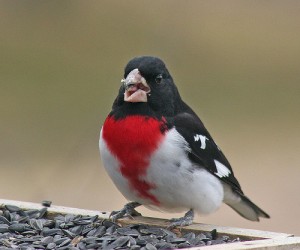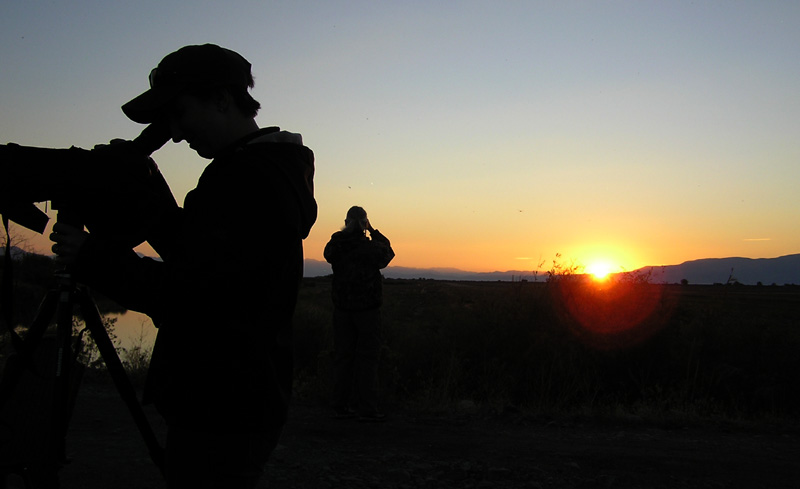Utah County Birders Newsletter
|
 |
Contents
November Meeting
Upcoming Field Trips
Ned's Notes
Bird of the Month
Field Trip
Report - Big Sit Provo Airport
Field Trip
Report - Sanpete County
Backyard Bird of the Month
October Hotline Highlights
NOVEMBER MEETING:
Wednesday,
November 10th, 2010 (Note meeting is on
Wednesday NOT Thursday).
You are cordially invited to a showing of “Ghost Bird”,
the award-winning documentary on the (possible) re-discovery of the fabled
Ivory-billed Woodpecker. The event will take place next Wednesday,
November 10th, 7:00 pm in the Bean Museum Auditorium on the Brigham Young
University campus. The Museum is located just east of the Marriott Center on the
northern edge of campus. Whether you agree or disagree with this “re-discovery”,
the story of the Ivory-billed is a fascinating one that teaches many lessons
about endangered species.
Come join us!
Meet at 7:00 PM in the Bean Museum Auditorium on the BYU Campus.
December Meeting: Thursday, December 9th - Preparation for the Provo CBC .
November 13, 2010: Antelope Island and Garr
Ranch. 7:00 a.m. - 12 p.m. Meet at Sam’s Club parking lot, 1313 S.
University Ave., Provo.
December 18, 2010: Provo CBC. The Provo
Christmas Bird Count is set for Saturday, December 18, 2010. Assignments are
given out at the Utah County Birders meeting on December 9th. If you can’t
attend the meeting, contact Ned Hill - 801-375-2417 (H) - 801-360-2600 (C) -
ned_hill@byu.edu
We are actively recruiting people to lead local half-day field
trips, any time, any place. If you would like to lead a field trip or if you
have any ideas for this year’s field trips, please contact Lu Giddings at -
seldom74@xmission.com.
Ned’s Notes
By Ned Hill – President, Utah County Birders
“Dinner with Dr. John P. O’Neill”
When I saw his name on the program, I knew I had to attend the closing banquet of the Association of Field Ornithologists (AFO) convention in Ogden on August 14th, 2010. My wife had gone on a trip with a couple of our granddaughters that day, so I invited my longtime associate and birding friend Ivan Call to join me. We arrived on the Weber State University campus in plenty of time to find our way around but soon discovered we were in the wrong place. While the AFO meetings had indeed been on the campus during the day, the banquet was shifted to the Ogden Marriott Hotel. So our time buffer was rapidly disappearing as we raced through the city to locate the Marriott. We walked in just before the dinner was to begin. A quick look around the ballroom showed us all the tables were filled except one near the front of the room. So, we quickly sat down there and began introducing ourselves to the others. That’s when we discovered a pleasant surprise: we were sitting at the head table (honestly, it looked just like the others) and I had taken a seat next to the honored guest and featured speaker for the evening—the very person I had come to hear: Dr. John P. O’Neill, formerly of Louisiana State University.
This man is legendary in the world of ornithology. Some of you may have read Parrot without a Name: The Search for the Last Unknown Birds on Earth by Don Stap. (If you haven’t, you owe it to yourself to do so!) It has become my favorite birding book because of the thrill of adventure and discovery that permeate its pages. In 1987 Don accompanied Dr. O’Neill and his associates—mostly from Louisiana State—on an expedition into a remote mountain range in Peru. This range, called the Cordillera Divisor, was isolated from the Andes mountains eons ago and formed essentially a mountainous island surrounded by a rainforest sea. Few people had ever visited the area. In other words, this just might be a place where new species of flora and fauna could be located.
As we talked, John O’Neill proved to be a quiet man of few words. His wife, an interesting and accomplished woman in her own right, accompanied him as did three other naturalist friends and associates. The animated dinner conversation revolved around the work John and his colleagues were undertaking to further study and help protect the rich variety of bird species in South America—especially those migrating there from North America. When the program began, John was called to the stand and presented with the AFO’s Skutch Medal for Lifetime Achievement in Field Ornithology. He was honored for his many significant contributions over decades of hard, creative and influential work. He essentially invented what is now called “Expeditionary Science”. He has published hundreds of papers detailing his discoveries. His remarkable ability as an artist is well displayed in the new, highly acclaimed Birds of Peru. Back in the 1960’s when many ornithologists were proclaiming that all bird species had been discovered, Dr. O’Neill and his teams plunged into the Peruvian rainforests and mountains, turning up about 15 new species over the next 45 or so years.
The Cordillera Divisor did turn out to contain a new bird or two. Parrot without a Name, which I confess to having read twice and am on a third time through, discusses the discovery of a new parrotlet and many of Dr. O’Neill’s other discoveries. After I read the book the first time, I had the opportunity to travel to Peru and was thrilled to find some of the birds O’Neill mentioned in his travels. And in June 2009, a small group of us spent two weeks in Peru and located one of the new species he discovered: Inca Wren in the forest surrounding Machu Picchu. We also searched for the “parrot without a name” (now called Amazonian Parrotlet) in its appropriate habitat but failed to locate the bird. Nevertheless, just being in the same general area where the bird might be found added excitement to our experience. Some of the other birds O’Neill and his teams are credited with finding are: Orange-throated Tanager, Elusive Antpitta, Pardusco, Selva Cacique, Long-whiskered Owlet and, recently, Red-banded Barbet (featured on the cover of Birds of Peru).
Dr. O’Neill is beginning to show his age and the effects of so many grueling trips into the wild. A recent stoke has slowed his speech—but not his mind. Nevertheless, he doesn’t plan on leading any more excursions into the untamed rainforests of Peru. He fears that the highways being constructed in the area of his discoveries may bring traffic, development, logging and agriculture thereby greatly diminishing the pristine habitats he suspects may harbor even more new species of wildlife. He told us he only recently learned that a new species similar to the Red-banded Barbet was discovered in a different mountain range. It is being analyzed at present.
Very
likely, none of us will have the thrill—as Dr. John P. O’Neill has—of
discovering a bird species new to science. But we can very likely have the
thrill of discovering a bird species new to us. Or, perhaps even the greater
thrill of helping a friend or a family member discover a bird species that is
new to them. I think that is one reason I so enjoy birding—our minds are
enlightened when we see something new, whether that new thing happens to be in
the rainforests of Peru or the Aspen tree in our own backyard.
Rose-breasted Grosbeak
Pheucticus ludovicianus
by Ned Bixler
 |
Two down, and two to go. When growing up in
Indiana, four of the birds that ate at our bird feeder, were the Northern
cardinal, red-headed woodpecker, blue jay, and rose-breasted grosbeak. Now that
I live in the West, these four birds seem to be only memories. However, this
year I had the good fortune to see two of this group. This summer, on a Utah
County Birders trip, I saw the red-headed woodpecker. Last month, in Wasatch
County, I had a chance to see the red-breasted grosbeak. Here’s hoping I will
see the other two in Utah.
The grosbeak is described as a medium-sized, stocky songbird. It has a large,
thick, pale, cone-shaped bill.
The male has a black head and back, with a red triangle on its breast. The
breast of the female has streaking on the it. The breast color and streaking of
the breast help in identifying the difference between the female black-headed
and rose-breasted grosbeaks. Beware of hybrids, in areas, where the two
grosbeaks overlap. Check your bird guides for a list of some of these
similarities.
Their food source is: insects, seeds, tree buds, and some fruits. It will come
to your feeder for sunflower seeds. Nests are a loose, open cup of twigs,
grasses, weed stems, decayed leaves of straw, lined with twigs.
Nest are found in trees, shrubs, or vines. Their clutch size is 1-5 eggs.
Click here for past 'Birds of the Month'.
The Big Sit - Provo Airport Dike - October 10, 2010
 |
|
Keeli Marvel and Douglas Mead on the Provo Airport Dike at Sunset |
Participants: Ned Bixler, Yvonne Carter, KC Childs,
Alona Huffaker, Eric Huish, Junece Markham, Keeli Marvel, Douglas Mead, Milton
Moody, Mark Mossing, Danny Nelson and Tuula Rose
Weather: Clear and Sunny
Location: Utah Lake - Provo Airport
Time At Location: 13 Hours 45 minutes 6:00 am - 7:45 pm
On October 10th several Utah County Birders spent the day birdwatching in one
spot at the East corner of the Provo Airport Dike road. The Utah Lake Provo
Airport Dike Sit Circle was covered from 6:00 a.m. to 7:45 p.m. This was our 9th
year participating on the big sit. Best birds were a Peregrine Falcon in the
morning and a Barn Owl, our last bird of the day, at 7:30 pm. The Peregrine made
some spectacular dives over the water south of our sit spot then circled out in
front of us in great morning light. It is interesting to watch how the bird
numbers and species at one spot changes throughout the day and from day to day.
Great and Snowy Egret, Merlin, Osprey, Wilson's Warbler and Lewis's Woodpecker
were all seen there the day before but nowhere to be found on Big Sit Day. We
were able to see or hear 54 species from our circle tying last year's total. Our
record is 58 species in one day and our 9 year (9 day) Big Sit Life List is now
at 107 species. We added two Big Sit Lifers this year - Peregrine Falcon and
Spotted Sandpiper.
Species List: Canada Goose 5, Mallard 10, Northern Shoveler 3, Green-winged Teal
5, Ring-necked Pheasant 1, Pied-billed Grebe 2, American White Pelican 7,
Double-crested Cormorant 2, Great Blue Heron 12, Black-crowned Night-Heron 1,
Northern Harrier 2, Sharp-shinned Hawk 1, Red-tailed Hawk 1, American Kestrel 2,
Peregrine Falcon 1, Virginia Rail 1, American Coot 1, Sandhill Crane 20,
Killdeer 70, American Avocet 100, Spotted Sandpiper 1, Greater Yellowlegs 4,
Long-billed Dowitcher 130, Wilson's Snipe 2, Franklin's Gull 7, Ring-billed Gull
300, California Gull 50, Caspian Tern 6, Eurasian Collared-Dove 3, Barn Owl 1,
Belted Kingfisher 1, Downy Woodpecker 1, Northern Flicker 7, Black-billed Magpie
2, Common Raven 2, Barn Swallow 100, Black-capped Chickadee 1, Marsh Wren 4,
Blue-gray Gnatcatcher 1, American Robin 40, European Starling 200, Cedar Waxwing
10, Orange-crowned Warbler 2, Yellow-rumped Warbler 20, Spotted Towhee 1, Song
Sparrow 1, Lincoln's Sparrow 1, White-crowned Sparrow 5, Red-winged Blackbird
500, Western Meadowlark 1, Yellow-headed Blackbird 4, Brewer's Blackbird 30,
House Finch 3, American Goldfinch 1.
SANPETE COUNTY - October 16, 2010
|
|
|
Sanpete County Field Trip
|
by Carol Nelson
As I sit here writing this trip report with rain falling outside my window and snow capped mountains to the east of me, I can’t help reflect on the beautiful day we had for our last field trip. Several of the birders remarked on the perfection of the day. The temperature, though cool to begin with, grew into flawlessness. The company was the best. I think there were about 20 individuals, some new faces, some comfortably familiar.
Lu told us we were headed for Wales reservoir. However we found that was not a direct destination. After traveling east up the canyon from Nephi, we turned off the road to the right into Log Canyon. I had never been there, and after having driven up and back would have been totally happy to just go along for the ride. Between the rock formations and fall colors it was a WOW! We saw a Golden Eagle, Kestrel, Steller’s Jay and more. The most enjoyable part of the canyon experience for me was being in the middle of a kettle of Chickadees, Nuthatches, Brown Creepers and Ruby-crowned Kinglets. They were abundant, and popped in and out of seemingly every branch on every tree.
 |
 |
| Patrea Marty | Joe Marty |
 |
 |
| Jeff Cooper | Douglas Mead |
 |
 |
| Martha Happ | Pat Jividen |
 |
 |
| Esther Duncan --Flora's daughter | Roger Pack -- Deloy's son |
We left the canyon and headed for the reservoir with a few roadside stops along the way. When we first pulled up to the reservoir it seemed to have only Canada Geese on it. A few good looks through the scope, however, showed us that the small flecks we could see were not dust flecks on our binoculars, but actual waterfowl and shorebirds.
We saw around 36 species so I would call the trip a success. The only negative comment I heard was that seat belts and birding do not go together.
I have included a few pictures of some of the newer faces on the trip so you can familiarize yourself with them.
Following is the list of species seen by most of us: Canada Goose, Gadwall, Mallard, Green-winged Teal, Ring-necked Pheasant, Northern Harrier, Red-tailed Hawk, Ferruginous Hawk, Golden Eagle, American Kestrel, American Coot, Killdeer, American Avocet, Long-billed Dowitcher, Eurasian Collared-Dove, Northern Flicker, Steller’s Jay, Western Scrub-Jay, Clark’s Nutcracker, Black-billed Magpie, Common Raven, Horned Lark, Black-capped Chickadee, Mountain Chickadee, Red-breasted Nuthatch, Brown Creeper, Ruby-crowned Kinglet, Mountain Bluebird, American Robin, European Starling, American Pipit, Red-winged Blackbird, Western Meadowlark, House Finch,House Sparrow, Great-tailed Grackle (Walmart parking lot bird)
October 2010
Milt Moody - Provo
A Yellow-rumped and a Yellow Warbler dropped by together on their
way on their way to a more warbler-friendly place.
Steve Carr - Holladay
Cooper's Hawk. Three wingbeats carried her 200 feet.
Eric Huish - Pleasant
Grove
Red-breasted Nuthatch and Mountain Chickadee - the Mountain birds
are coming down this fall.
Dennis Shirley - Elk Ridge
25 Sandhill Cranes circling high over the yard. Could hear them but was
hard to find them, they were so high up.
Yvonne Carter - Highland
Juncos started appearing at my feeders.
Bonnie Williams - Mapleton
A big flock of Canada Geese flew over early one morning.
Cheryl Peterson - Provo
2 Mountain Chickadees